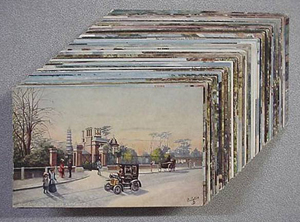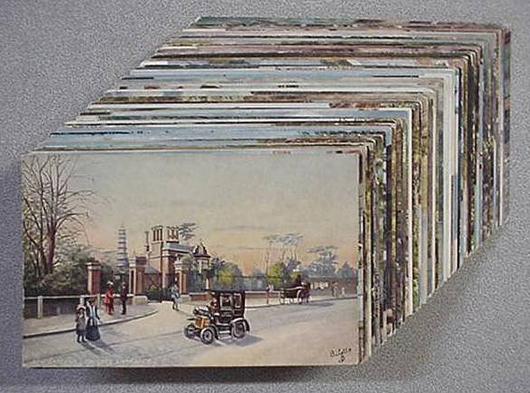
WAUCONDA, Ill. (AP) – At the turn of the 20th century postcards were quickly becoming the rage as an early form of social media—a quick and fun way to share images of various subjects and cultures across long distances.
Though quaint compared to today’s rapid-fire technology, postcards retain great interest for collectors, researchers and others for historical background and as expressive illustrations of the life and times of bygone eras.
With about 3 million postcards and related materials, one of the most renowned collections in the world is the Lake County Discovery Museum’s Curt Teich Postcard Archives, nestled in an old farmhouse at the Lakewood Forest Preserve near Wauconda.
Despite its ample size, the archive is growing in a significant way with a gift valued at $260,000 from Leonard A. Lauder, chairman emeritus of the Estee Lauder Cos. Inc. Lauder is a well-known philanthropist and businessman, and considered one of the world’s most prominent collectors of postcards.
Shipped a few weeks ago in shoebox-size brown boxes with reinforced sides, the 35,500 individual cards are Lauder’s collection of the “Oilette” series—a type of art for the people—produced in the early 20th century by the London-based Raphael Tuck & Sons.
“That’s a term they coined because they wanted the public to think of them as little oil paintings,” said Katherine Hamilton-Smith, director of cultural resources for the Lake County Forest Preserve District, which runs the museum and archives.
“It was their business, but for altruistic reasons, they were trying to provide the general public with beautiful images.”
The gift includes funds for storage, preservation, cataloging and digitalization of the cards, which will become part of the Teich archives and likely one of the opening exhibitions when the Discovery Museum moves to much larger quarters in Libertyville in two to three years.
“It shows another aspect of how important postcard images were in the 20th century,” according to Hamilton-Smith.
Lauder, the eldest son of Estee Lauder of skin care product fame, has no connection to Lake County and never visited the Teich archives, but its reputation is known by collectors. Hamilton-Smith said she has had periodic contact with Lauder for about 15 years.
He was impressed by the archives’ commitment to single postcard publishers and thought his Tuck postcards, part of a larger general collection amassed over 50 years, would be a good companion to the Teich collection, according to Lynda Klich, curator of the Leonard A. Lauder postcard collection.
“I just know it was important for him to know his collection had a good home,” said Klich, who visited the archive last fall. “We were very excited about the possibilities of having it more publicly accessible.”
It is Lauder’s second gift to a museum. In 2004, he donated a Japanese collection of more than 20,000 postcards to the Museum of Fine Arts Boston. He has pledged another 100,000 postcards to that institution, with the “The Postcard Age” exhibition scheduled to open Oct. 23, Klich said.
The postcard craze hit its zenith between 1895 and the beginning of World War I, she said. At the forefront was Raphael Tuck & Sons, which had evolved from selling and framing pictures at a shop in London to become the leading British postcard producer, selling cards in other countries including France and the United States.
Entering the U.S. market in 1900, the company within a few years was introducing dozens of new series postcards a week to meet an insatiable public demand.
In 1903, artists commissioned by the company, including prominent names such as Charles Flower and Albert Operti, began producing the Oilette series. It was described by the company as “veritable miniature oil paintings.”
“This was a way for everybody to have art,” explained Christine Pyle, manager of historical resources for the Lake County Forest Preserve District. She said the brush strokes are sometimes visible on the postcards, especially in the early versions.
“It represents another company we didn’t have in our collection,” she said. “This is really nice to have examples from a large, very well-known, highly collectible company.”
Pyle said postcards were so popular at one time that people often would buy two—one to send and one to keep. Tuck cards spanned many subjects, but their bread and butter was views of towns and cities, Hamilton-Smith said.
Curt Teich & Co., known for its advertising postcards, operated in Chicago until 1978.
According to Hamilton-Smith, Teich’s son, Ralph, wanted to find a public entity that would understand, value and provide access to what amounted to a visual history of the 20th century.
A Lake Forest resident, Ralph Teich approached the Lake County Discovery Museum, which shared the vision. The original collection formed the nucleus of the archives, which marks its 30th anniversary this year.
___
Information from: Daily Herald, http://www.dailyherald.com
Copyright 2012 Associated Press. All rights reserved. This material may not be published, broadcast, rewritten, or redistributed.
AP-WF-05-04-12 1036GMT
ADDITIONAL IMAGE OF NOTE



